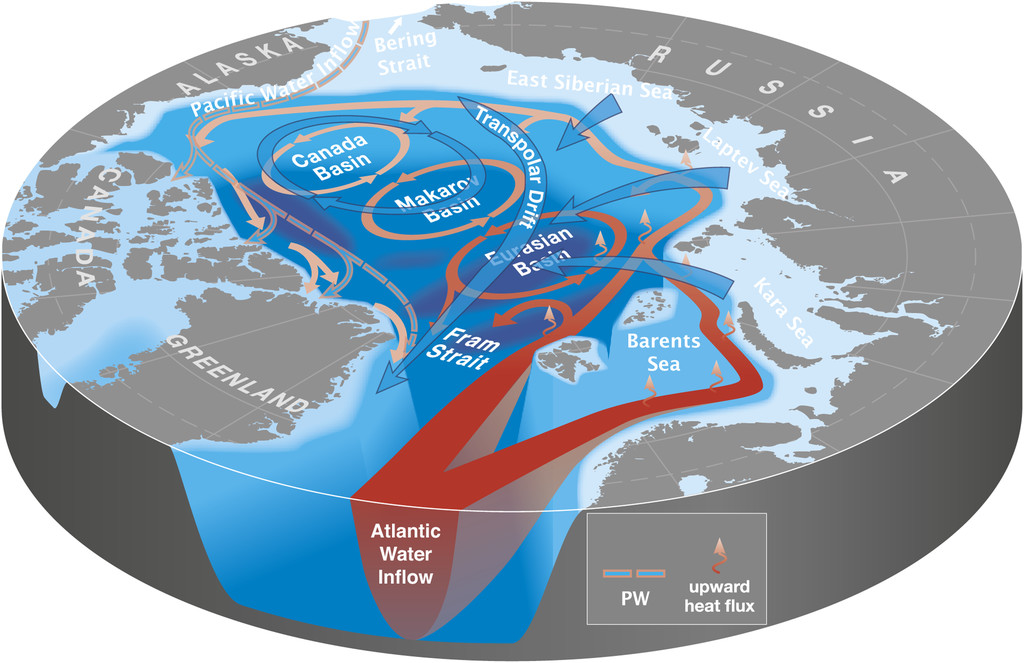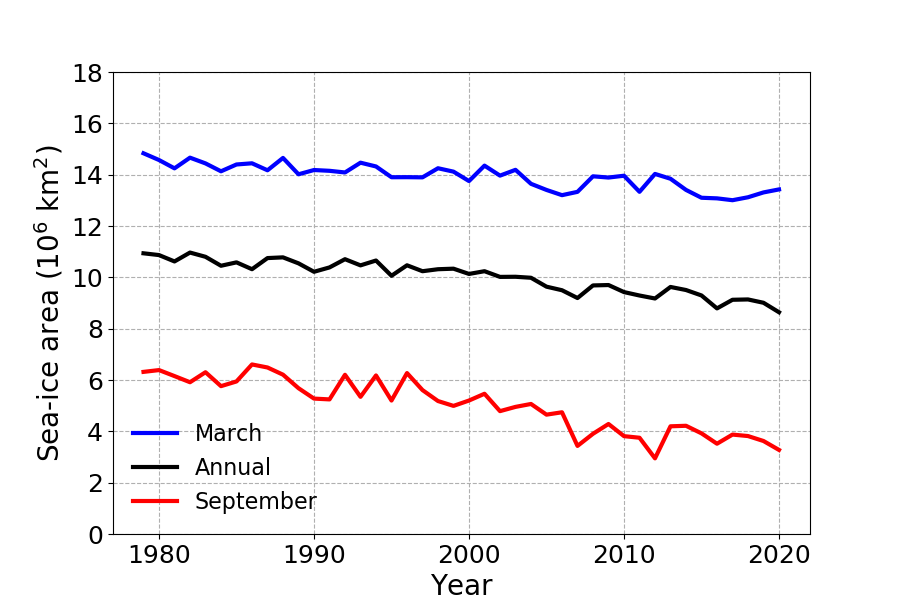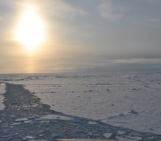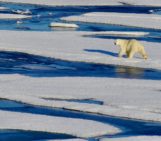
Fig. 1: Main ocean currents in the Arctic Ocean, including Atlantic Water (red), Pacific Water (pink/blue) and surface water (blue) [Credit: Fig. 3 of Carmack et al., 2015; © American Meteorological Society. Used with permission].
The current retreat of Arctic sea ice is a major sign of ongoing climate changes. And it could almost disappear during summer in a few decades from now, depending on the amount of greenhouse gases we will emit into the atmosphere. In this context, understanding what are the exact causes of this sea-ice loss is important. One of these causes is the amount of heat transported by the ocean (which depends on both the temperature and the velocity of ocean currents), for which the different pathways are shown in our Image of the Week (Fig. 1). In this blog post, we are going to see why that is the case, and what oceanic regions have the biggest influence on the Arctic sea-ice retreat.
The changing Arctic sea ice
Each winter, due to low air temperatures, sea ice forms at high latitudes; each summer, part of it melts: this is what we call a seasonal cycle (see this previous post and this nice interactive plot of the National Snow & Ice Data Center). The problem is that in the Arctic, sea ice has been retreating from year to year since the late 1970s (see this post). There has been a loss of about 2 million km2 (-20 %) in the total area of Arctic sea ice between 1979 and 2020, with a stronger decrease in summer compared to winter (Fig. 2; see this article).
Based on the extrapolation of current observations of sea ice (see this article) and future projections of climate models (see this article), the Arctic Ocean could become almost ice free in summer before the middle of this century, so in less than 30 years. This could lead to dramatic changes in our climate (for example a slowdown of the ocean circulation in the North Atlantic and/or impacts on the atmosphere at mid-latitudes).
We have seen in a previous post that these changes in Arctic sea ice have been caused by a combination of three main factors: anthropogenic global warming (via the emission of greenhouse gases), internal variability (caused by the chaotic nature of the climate), and positive feedback mechanisms (by which a change in the climate can amplify). But what are the exact processes behind these factors?

Fig. 2: Evolution of Arctic sea-ice area from 1979 to 2020 using OSI SAF satellite observations (Lavergne et al., 2019). The blue and red curves are for March and September, respectively. The black curve is the annual mean.
How is the ocean impacting sea ice?
Sea ice mainly melts from the top, through atmospheric processes, and from the bottom, via ocean processes. One of these ocean processes is heat transport from the ocean. The Atlantic and Pacific Oceans carry a lot of heat to the Arctic Ocean: see the red arrow for the Atlantic Water and the pink/blue arrow for the Pacific Water in our Image of the Week (Fig. 1). Recent observations show that the increase in Atlantic Ocean heat transport has led to strong reductions in Arctic sea-ice area (see this study and this study).
In the framework of the EU OSeaIce project, we aimed to investigate the exact processes by which the ocean heat transport affects sea ice in the Arctic. So we designed a set of sensitivity experiments with the global climate model EC-Earth. In these experiments, we artificially increased sea-surface temperature in various regions of the North Atlantic and North Pacific Oceans, and run the model over a 50-year time period. We compared results of these experiments with a control experiment, corresponding to the present-day climate.
We found that the larger the level of warming and the domain where the temperature is increased, the larger the increase in ocean heat transport, resulting in a stronger sea-ice loss. More surprisingly, we also found that an increase in sea-surface temperature in the North Pacific translates into a more efficient melting of Arctic sea ice compared to a similar increase in the North Atlantic (Fig. 3). The exact reason why that is the case is beyond the scope of this post but more details can be found in our study.
In our experiments, we also found that the increase in ocean heat transport leads to more melt at the bottom of sea ice in the central Arctic, as well as to a decrease in growth of sea ice at its base along the sea-ice edge. This confirms that ocean heat transport is a key player in the recent changes in sea-ice area.

Fig. 3: Change in mean March Arctic sea-ice volume against change in mean ocean heat transport through all Arctic straits (in terawatts; 1 TW = 10^12 W) between the sensitivity experiments and the control experiment (1 point for each experiment). Dots are for Atlantic experiments (a_atl is the corresponding regression slope), and crosses are for Pacific experiments (a_pac is the corresponding regression slope) [Adapted from Fig. 9c of Docquier et al., 2021].
What is projected?
We have already said that sea ice is projected to continue its rapid decline over the next years, especially in summer. As the ocean continues to warm, the impact of ocean heat transport should also increase in the future. However, there is still hope to slow this process down, as it strongly depends on the amount of greenhouse gases we emit into the atmosphere (see this post). The future of our climate is (at least partly) within our hands.
Further reading
- Docquier et al. (2021). ‘Impact of ocean heat transport on the Arctic sea-ice decline: a model study with EC-Earth3’. Climate Dynamics, https://doi.org/10.1007/s00382-020-05540-8.
- See page 44 of the seventh edition of the Project Repository Journal from the European Dissemination Media Agency: Docquier, D. ‘How the ocean influences Arctic sea ice’.
- OSeaIce: Two-way interactions between ocean heat transport and Arctic sea ice. CORDIS EU research results.
- Carmack, E. et al. (2015). ‘Toward quantifying the increasing role of oceanic heat in sea ice loss in the new Arctic’. Bulletin of the American Meteorological Society, https://doi.org/10.1175/BAMS-D-13-00177.1.
Edited by Francesco Avanzi
 David Docquier is a post-doctoral researcher at the Royal Meteorological Institute of Belgium. His study focuses on the interactions between the ocean and atmosphere using tools from nonlinear sciences. His work is embedded within the JPI-Oceans/JPI-Climate ROADMAP project.
David Docquier is a post-doctoral researcher at the Royal Meteorological Institute of Belgium. His study focuses on the interactions between the ocean and atmosphere using tools from nonlinear sciences. His work is embedded within the JPI-Oceans/JPI-Climate ROADMAP project.




